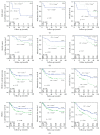Prognostic Value of Homotypic Cell Internalization by Nonprofessional Phagocytic Cancer Cells
- PMID: 26504802
- PMCID: PMC4609350
- DOI: 10.1155/2015/359392
Prognostic Value of Homotypic Cell Internalization by Nonprofessional Phagocytic Cancer Cells
Abstract
Background: In this study, we investigated the prognostic role of homotypic tumor cell cannibalism in different cancer types.
Methods: The phenomenon of one cell being internalized into another, which we refer to as "cell-in-cell event," was assessed in 416 cases from five head and neck cancer cohorts, as well as one anal and one rectal cancer cohort. The samples were processed into tissue microarrays and immunohistochemically stained for E-cadherin and cleaved caspase-3 to visualize cell membranes and apoptotic cell death.
Results: Cell-in-cell events were found in all of the cohorts. The frequency ranged from 0.7 to 17.3 cell-in-cell events per mm(2). Hardly any apoptotic cells were found within the cell-in-cell structures, although apoptotic cell rates were about 1.6 to two times as high as cell-in-cell rates of the same tissue sample. High numbers of cell-in-cell events showed adverse effects on patients' survival in the head and neck and in the rectal cancer cohorts. In multivariate analysis, high frequency was an adverse prognostic factor for overall survival in patients with head and neck cancer (p = 0.008).
Conclusion: Cell-in-cell events were found to predict patient outcomes in various types of cancer better than apoptosis and proliferation and might therefore be used to guide treatment strategies.
Figures




References
-
- National Library of Medicine (US) Medical Subject Headings. National Library of Medicine (US), Bethesda, Md, USA, 2011, http://www.nlm.nih.gov/cgi/mesh/2014/MB_cgi?mode=&index=25547&field=all&....
MeSH terms
Substances
LinkOut - more resources
Full Text Sources
Other Literature Sources
Medical
Research Materials

